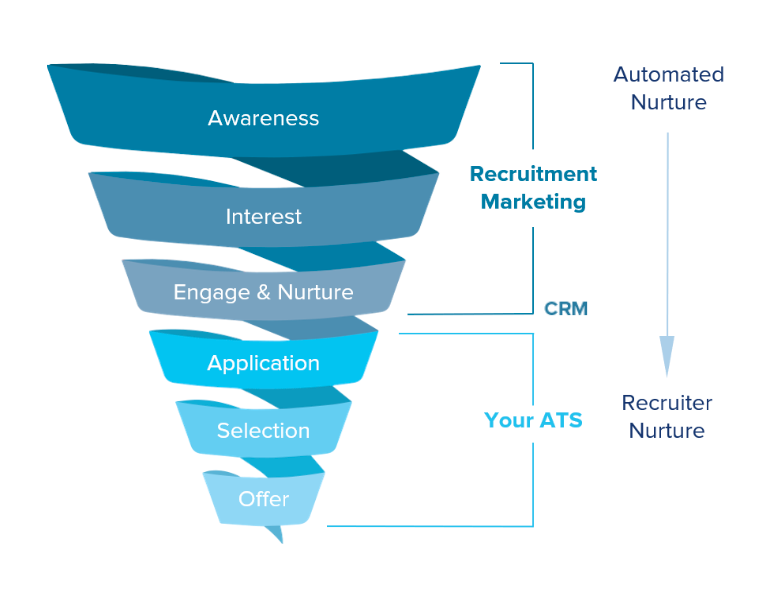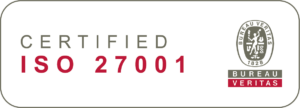In 2025, recruiting tech isn’t just evolving—it’s redefining how companies attract and hire top talent. At the heart of this transformation are Applicant Tracking Systems (ATS) and Candidate Relationship Management (CRM) solutions. These tools have become essential for hiring teams, with 98% of Fortune 500 companies and 66% of mid-to-large businesses relying on an ATS to streamline their hiring processes.
But here’s the catch: while many recruiters swear by one system, using only an ATS or CRM means leaving valuable opportunities on the table. Integrating both can supercharge your hiring strategy, improving candidate engagement, reducing time-to-hire, and boosting placement rates by up to 45%.
This guide breaks down what sets ATS and CRM apart, how they work together, and why leveraging both is the real game-changer for hiring teams looking to stay ahead in a competitive talent market.
What Are ATS and Recruiting CRM?

Recruiting technology has revolutionized the way companies find, track, and engage with talent. But with so many tools available, it’s easy to get lost in the terminology. Two of the most widely used technologies in talent acquisition are Applicant Tracking Systems (ATS) and Candidate Relationship Management (CRM) systems—each playing a unique role in recruitment.
While both systems help recruiters manage candidates, they serve different purposes. If an ATS is your digital filing cabinet for managing applications and ensuring compliance, then a CRM is your relationship-building tool that keeps talent engaged long before they apply. Let’s break them down further.
Applicant Tracking System (ATS): Your Digital Hiring Manager
An Applicant Tracking System (ATS) is the go-to software for recruiters handling active job openings. This system tracks applicants only when a specific job requisition is open, meaning candidates must apply for a role to be entered into the system.
Key Benefits of an ATS
-
Automated Candidate Management
One of the biggest advantages of an ATS is that it eliminates the need for manual tracking, reducing reliance on spreadsheets and outdated processes. It automatically collects and organizes applications, letting recruiters focus on screening and evaluating top candidates rather than getting lost in paperwork. -
Resume Parsing & Keyword Matching
Most ATS platforms use resume parsing technology to extract relevant details from applications, making it easier for recruiters to search for candidates based on keywords, skills, and qualifications. This feature is crucial when handling high volumes of applications, as it quickly identifies the most relevant candidates for a position. -
Compliance & Diversity Tracking
Beyond simplifying hiring, an ATS plays a crucial role in ensuring equal opportunity compliance. By tracking demographic data such as age, gender, and ethnicity, an ATS helps organizations comply with legal regulations like the Equal Employment Opportunity (EEO-1) reporting requirements in the U.S. or the Equality Act 2010 in the U.K. Some systems even allow for anonymous application screening to reduce unconscious bias in hiring decisions. -
Potential Downsides
While an ATS can significantly streamline recruitment, it’s not without flaws. Many applicants worry about their resumes being filtered out due to rigid keyword-matching algorithms. Additionally, duplicate candidate profiles can be a common issue if the system doesn’t have robust deduplication features in place. Using third-party integrations or AI-powered solutions can help mitigate these challenges.
Candidate Relationship Management (CRM): Your Talent Pipeline Builder
Unlike an ATS, which focuses on active job openings, a Candidate Relationship Management (CRM) system is designed to build and maintain relationships with both active and passive candidates—even when there’s no open role.
A CRM acts as a long-term talent pipeline, ensuring recruiters have a warm pool of potential hires before a position becomes available. This is especially valuable for industries facing ongoing talent shortages or companies that prioritize proactive recruitment.
Key Benefits of a CRM
-
Proactive Talent Sourcing & Engagement
With a CRM, recruiters can keep potential candidates engaged even if they aren’t actively hiring. Candidates don’t need to apply for a job to be in the CRM—they just need to express interest in working for your company, whether through a career fair, networking event, referral, or social media interaction. This means your talent pool is always full, even before job requisitions are created. -
Automated Candidate Nurturing
A strong CRM system ensures that candidates stay engaged over time through automated follow-ups, personalized email campaigns, and regular touchpoints. Instead of losing touch with top talent, recruiters can maintain relationships by providing company updates, sharing relevant job opportunities, or offering career development content. This creates a more positive candidate experience, increasing the likelihood that passive candidates will consider future opportunities. -
Data-Driven Employer Branding
A well-maintained CRM provides valuable candidate engagement analytics. Recruiters can track open rates, response rates, and levels of interaction, helping them identify what messaging resonates most with their audience. This data allows talent acquisition teams to refine their employer branding strategy and tailor recruitment marketing efforts for better results. -
Potential Downsides
The main challenge with CRMs is that they require consistent engagement. Unlike an ATS, which is more automated in handling applications, a CRM demands a strategic approach to outreach and talent pipeline management. Recruiters must be proactive in maintaining relationships and ensuring that candidates feel valued, even if they aren’t immediately being considered for a role.
ATS vs. CRM: Which One Do You Need?
Now that we’ve broken down what each system does, let’s compare them side by side:
| Feature | ATS: Tracks Applicants | CRM: Builds Relationships |
|---|---|---|
| Primary Function | Manages applications for active job openings | Engages and nurtures talent for future hiring |
| When Candidates Enter | Only when they apply for a job | When they show interest (networking, events, referrals) |
| Main Benefit | Streamlines recruitment workflow & compliance | Improves long-term talent pipeline & engagement |
| Best For | High-volume hiring, structured application tracking | Proactive hiring, employer branding, talent nurturing |
At their core, ATS and CRM systems serve distinct but complementary roles in the hiring process.
- A recruiting CRM is all about building relationships and nurturing talent pipelines, allowing recruiters to engage passive candidates long before a role even opens. This proactive approach is crucial for hard-to-fill positions, where waiting until the last minute to source candidates can significantly slow down hiring.
- On the other hand, an ATS is built to manage applicants who have already entered the system—tracking their progress, streamlining hiring workflows, and automating administrative tasks. This improves three critical hiring metrics: time to hire, cost per hire, and quality of hire.
Many companies ask: “Do I need an ATS or a CRM?” The best answer? You should go with both.
By combining these two systems, companies can move from reactive hiring (only recruiting when a job opens) to proactive talent acquisition (building relationships before hiring needs arise) – leading to a faster, smarter, and more effective recruitment process.
ATS vs CRM: When Do You Need Them Both?

Integrating a recruiting CRM and an ATS isn’t just about convenience—it’s about building a scalable, data-driven, and candidate-friendly hiring strategy. Here’s when using both can be a game-changer:
1. You Need a Unified View of Your Talent Pool
Using an ATS and a CRM separately means dealing with two separate databases, which can lead to profile duplication, lost data, and inefficiencies. A seamless ATS-CRM integration consolidates your talent pipeline, eliminating redundancies and giving recruiters a full picture of every candidate’s journey—from passive interest to active application.
An ATS efficiently organizes and screens applicants, but a CRM provides critical pre-application insights, such as a candidate’s previous interactions, skills, and engagement level. This data enhances decision-making, allowing recruiters to tailor their outreach and interview approach—ultimately speeding up hiring and improving candidate quality
2. You Want to Fill Open Roles Faster with Qualified Talent
Data-driven hiring is non-negotiable in 2025. Recruiting teams leveraging both an ATS and CRM have a major advantage when it comes to speed and quality of hire.
-
An ATS filters and ranks active applicants, but it only pulls from submitted applications.
-
A CRM expands the talent pool by tracking passive candidates, silver medalists, and past applicants, ensuring you don’t overlook great talent just because they didn’t apply this time.
Businesses prioritizing time-to-hire and quality-of-hire metrics benefit significantly from a combined ATS-CRM strategy. It allows them to act quickly on strong leads, reducing reliance on job postings and costly external recruitment
3. You Want to Strengthen Your Employer Brand
An ATS is designed to streamline hiring, but it lacks candidate engagement and employer branding tools. A CRM fills this gap by helping you nurture relationships, personalize outreach, and improve brand perception.
-
A recruiting CRM keeps passive candidates engaged with targeted content, updates, and job alerts.
-
Candidates who feel valued and informed are more likely to apply and accept offers—boosting employer reputation.
-
69% of candidates would refuse a job offer from a company with a bad reputation, even if unemployed.
By freeing up recruiter bandwidth from manual tasks, an ATS enables teams to focus on employer branding initiatives within the CRM, ensuring a consistent, positive candidate experience.
4. You Need Advanced Analytics and Compliance Reporting
Both ATS and CRM systems provide valuable analytics, but they serve different purposes:
-
An ATS tracks hiring performance, cost-per-hire, and compliance metrics. Some ATS platforms even generate EEO-1 reports, helping US employers meet Equal Employment Opportunity (EEO) regulations.
-
A CRM delivers insights into candidate engagement, sourcing effectiveness, and pipeline health—allowing recruiters to refine outreach strategies.
ATS-generated reports help track diversity hiring metrics, time-to-fill trends, and hiring source efficiency, while a CRM provides conversion data on talent outreach efforts. By using both systems together, recruiters gain a 360-degree view of hiring effectiveness—ensuring smarter, data-driven decisions
5. You Need Full Coverage of the Talent Funnel

The talent acquisition funnel spans multiple stages—from sourcing and engagement to hiring and onboarding:
-
Recruiting CRM: Handles the top of the funnel, driving awareness, interest, and engagement.
-
ATS: Manages the application-to-offer process, automating workflows and ensuring compliance.
By aligning ATS and CRM functionalities, recruiters create a seamless hiring experience, keeping candidates engaged before, during, and after the hiring process—leading to higher acceptance rates and stronger long-term hires
To Conclude…
We have gone through some fantastic functions you can benefit from a recruiting CRM vs ATS integration, which seems promising and worth a try. And yet, one still has to face particular worrying possibilities if one does not operate thorough considerations.
We hope our analysis has provided the critical information for you to make your own decision. Also, technology upgrades are costly and sometimes risky, but this integration can be a great work advancement. If you still wonder if recruiting CRM software is necessary to complement your ATS, check out our article on candidate relationship management facts.

Team Rakuna
The Rakuna Team comprises a diverse group of professionals hailing from various corners of the world.
With a passion to enable organizations to hire their next waves of talents, we are dedicated to help organizations stay updated on important recruiting technology and industry best practices.


